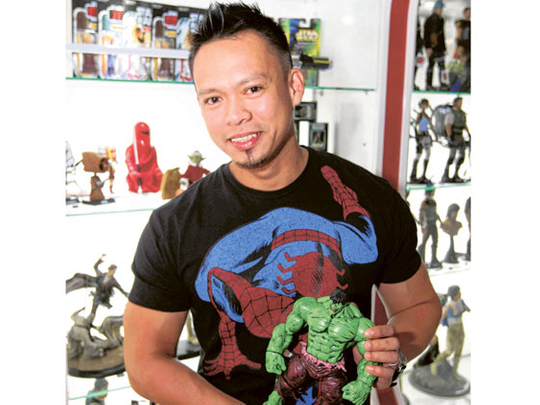
Dubai: For as long as he can remember, Arabie Mark dela Cruz has always had his eyes peeled for replicas of his favourite super heroes. Wherever he goes, he's constantly on the hunt, hoping to discover a gem of a toy in the back of someone's shop or in a private collection.
Over the years, he has accumulated more than 300 pieces which include models of Spiderman, Captain America, the Avengers and X-Men. The Filipino expatriate, who sells home appliances by day, started his collection due to his childhood passion for action figures. He swears that cost is not an issue, saying that his toys give him a sense of satisfaction and happiness.
"It's the same feeling a person gets when he discovers something of rare value," he says. "Some people feel relaxed if they have an aquarium in the house or if they go to the beach. To me, when I go home and see my toys, I feel relaxed."
But dela Cruz discovered he could make money at the same time. Back in high school, he would trade the toys he'd been keeping for a while and since they were rare collectibles, he made some profitable returns. "Actually, since high school, I stopped asking for allowance from my mother because of that," he says.
Double the price
In a recent trip to the Philippines, he pocketed Dh3,000 to Dh4,000 profit from the sale of his Transformers-inspired toys that had been sitting in his collection for three years. Some of the items originally cost him around Dh200 each and he managed to trade them for almost double the price, plus extra toys.
However, he insists he only sells his treasured toys to a collector. "I want to pass on my toys to people who value and enjoy them, not the ones who collect them merely for profit."
How does one manage to add monetary value to his collection? Dela Cruz scours internet forums and networks with fellow collectors to get the perfect piece. He also buys directly from the suppliers and avoids newly released items at high-end shops to get the best price. "It takes patience to find a valuable item for a good price," he says.
"If there's one thing that toy collectors should know, they should not just buy anything they see. They should be discerning. Buy only the things you really like."
Iranian art collector Ramin Salsali shares dela Cruz's view that collecting should not be driven by any financial gain. "Collecting an item is in response to the appreciation for it — the appreciation for its shape and beauty, or its relation to a situation," he said.
More than 400 pieces
Salsali started collecting when he was 21. The first item that landed in his collection was a painting of a famous artist from Berlin which he acquired at no cost, as it was a settlement for the artist's debt. Today, his collection consists of more than 400 pieces including paintings, photographs, video art, sculptures and installations.
His passion for the art has been instrumental in the opening of the Salsali Private Museum at Al Serkal Avenue, Al Quoz last November. Although he agrees that buying collectibles can be a smart investment option, Salsali points out a true collector will never consider his collection as an investment. "The admiration for any pieces shall not be polluted with the idea of creating money from the collection," he says.
Kourosh Nouri, owner of another gallery called Carbon 12 on Al Serkal Avenue, says he also collects with the heart, but has made some money. "I sold art works I bought as a young collector and sold them with hefty profit. However, initially, I wasn't selling for profit, but in order to buy other art works," Nouri says.
"Collecting could be very profitable, but I truly believe that's missing the point."








